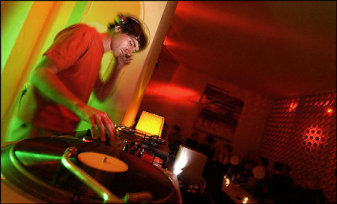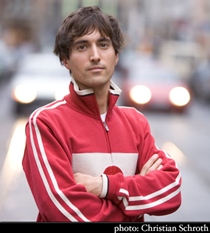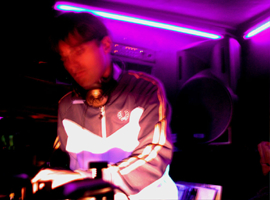Mason Bates: Bringing Electronica to the Concert Hall
By Stephen Brookes • The Washington Post • February 21, 2007
_______________________________________________________________________
 Tomorrow night at the Kennedy Center, Al Gore's worst nightmare will come to pass. Massive glaciers will calve from the ice caps and crash into the sea. Temperatures will rise, boiling the oceans into a fury as the planet gets hotter and hotter -- until finally a massive flood inundates the continents.
Tomorrow night at the Kennedy Center, Al Gore's worst nightmare will come to pass. Massive glaciers will calve from the ice caps and crash into the sea. Temperatures will rise, boiling the oceans into a fury as the planet gets hotter and hotter -- until finally a massive flood inundates the continents.
That's the apocalyptic plan, anyway, for the premiere of "Liquid Interface," a new work by the young California composer Mason Bates. Commissioned by the National Symphony Orchestra, the piece may be the first attempt to deal musically with the drama of global warming. But that's not the only new thing about this work. Throughout the performance the composer himself will be sitting at the heart of the orchestra, working a laptop and generating huge waves of electronica -- pulsing trip-hop rhythms straight from the dance clubs of the Left Coast.
Wait -- the NSO playing . . . techno?
"There's plenty of rhythmic activity in the piece, and a lot of trip-hop beats," confirms Bates. "But I don't think you'll see people doing head-spins in the aisles."
At age 30, Bates is already rocking the classical world. One of the fastest-rising young composers in the country, he's written a string of serious works for serious orchestras -- including the Los Angeles Philharmonic, the Winston-Salem Symphony and now the NSO -- and won an array of prestigious awards, from the Rome Prize to a fellowship from Tanglewood. Born and reared in Richmond, he trained at Juilliard and is now finishing up a doctorate at the University of California at Berkeley.
By night, Bates heads for the clubs of San Francisco, where as DJ Masonic he churns out driving, sophisticated dance music at places like Skylark and Cloud 9. Armed with a computer and electronic drum pad, he plays into the small hours of the morning, weaving complex, highly rhythmic sonic landscapes.
It would seem to be as far from the concert hall as you could get. But over the last few years, Bates has been bridging the two worlds with a natural ease, writing music that marries the intellectual seriousness of classical with the visceral kick of techno. "He's one of the few people who can mix electronica and pop with abstract music, and do it well," says Pulitzer Prize-winning composer John Corigliano. Other composers have tried, he says, usually just dishing up a porridge of "bad classical music and bad pop music at the same time." But Bates's pieces, he says, "are like little jewels -- he inhabits this fantastic sound world."
"He's one of the few people who can mix electronica and pop with abstract music, and do it well," says Pulitzer Prize-winning composer John Corigliano. Other composers have tried, he says, usually just dishing up a porridge of "bad classical music and bad pop music at the same time." But Bates's pieces, he says, "are like little jewels -- he inhabits this fantastic sound world."
Orchestral music and techno are more alike than they seem: They're both instrumental, both are designed for open, cavernous spaces and both have a near-infinite potential for texture and color. Put them together, Bates says, and a world of "very pregnant possibilities" opens up:
"There's a lot of cross-pollination. Orchestral writing changes what you do in electronica, and when you spend any time in an electronic studio, you definitely think about E-flat on the oboe in a new way. And the long spans of time in electronica -- where textures shift very slowly -- change your perspective. My approach to musical architecture has become far more stretched out."
But electronica's most important contribution, says Bates, may be a propulsive, physical energy that's been conspicuously absent from much of the rigidly codified "serious" music of the past 50 years.
"I need to be moved viscerally by a piece of music," he says. "Music's not like any other art form -- you can't escape the physical quality of it. It inhabits your imagination and your bloodstream at the same time. Ultimately I want a piece to pay intellectual dividends -- but I have to be captivated by it first."
In a sense, Bates's mash-up of techno with the orchestra is bringing things full circle. Electronica's roots go back to composers such as Edgard Varese (whose 1958 "Poeme Electronique" may have launched the genre) and Pierre Schaeffer, who used sound samples in the 1950s in a style called "musique concrete." And a few composers of the late 20th century -- the pathbreaking Iannis Xenakis, in particular -- are routinely cited by electronica artists as major influences.
But electronic sounds never caught on in classical music the way they did in pop, where they've blossomed in everything from Top 40 to favela funk. And, since emerging in the 1990s as a style in its own right, electronica has spawned an array of genres and subgenres: acid house, drum 'n' bass, electroclash, booty bass, etc. Bates seems uniquely positioned to bring all of this into classical music. "What Mason does is, in a way, a throwback to the 1960s, when composers were first starting to use electronics with the orchestra," says NSO Music Director Leonard Slatkin. "But very rarely were the electronics integrated into the music; they always stuck out as just an added thought. With Mason, they're an integral part of the work."
Bates seems uniquely positioned to bring all of this into classical music. "What Mason does is, in a way, a throwback to the 1960s, when composers were first starting to use electronics with the orchestra," says NSO Music Director Leonard Slatkin. "But very rarely were the electronics integrated into the music; they always stuck out as just an added thought. With Mason, they're an integral part of the work."
Bates first bridged the classical-electronica gulf in a 2004 commission for the Los Angeles Philharmonic, "Omnivorous Furniture." Written for sinfonietta and electronica, the work's success quickly led to more commissions, including a piece for Juilliard's 100th anniversary called "Digital Loom" (for organ and electronica). Word of Bates's talent reached Slatkin, who contacted the composer two years ago to write a 20-minute work.
It was propitious timing; Bates already had an idea for a major piece. "I was living in Berlin, near a huge lake there called the Wannsee," he recalls. "I had been watching it go through extremes, from totally frozen to hot and humid in a matter of weeks. So I thought it would be fascinating to do a new kind of water piece -- not just Debussy's play of the waves, but a piece on water in all its forms, moving from ice to evaporation.
"And I wanted to look at it through the prism of the 21st century. So the whole piece is structured around things gradually heating up."
When the work premieres tomorrow (in a program that includes the more traditional fare of Mendelssohn's Violin Concerto in E Minor and Tchaikovsky's Symphony No. 6), it will open with a roar -- actual recordings of glaciers calving in the Antarctic -- while the orchestra picks up the imagery, building huge blocks of sound that shift, drift and start to break apart as the temperature rises. As that's happening, says Bates, "the electronics enter with these very fat beats and slow-motion trip-hop beats," based on samples of actual water sounds. Propelled by the beat, the orchestra creates a swirling world of sound, bringing the work to an apocalyptic (or even biblical) flood. But then the waters recede, calm returns, and a simple melody floats over peaceful sounds recorded at the side of the Wannsee, until the final notes simply evaporate away.
"You end up," says Bates, "in a sort of greenhouse paradise, where it's very balmy."
Hold on -- global warming has a happy ending?
"Well, I'm leery of preaching," he says, noting that it was the dramatic aspects of global warming, rather than the politics, that intrigued him. "Absolutely, composers should address the big issues of the day, but I'm not sure a composer is going to have the answers. What's important is to pose the questions."
© 2007 The Washington Post Company
Photos: Max Lautenschlager; Christina Schroth
References (5)
-
 Response: Radio City Christmas Spectacular TicketsIt’ s not clear what the remixes would sound like or even which tunes will be getting a re- jiggering, but there are a few team- ups that would be ideal. Timberlake should lend a bit of harder- edged disco to the sorta- dance- ready“ Sex on Fire.” Linkin Park could ...
Response: Radio City Christmas Spectacular TicketsIt’ s not clear what the remixes would sound like or even which tunes will be getting a re- jiggering, but there are a few team- ups that would be ideal. Timberlake should lend a bit of harder- edged disco to the sorta- dance- ready“ Sex on Fire.” Linkin Park could ... -
 Response: wintel pro tv boxwintel pro tv box
Response: wintel pro tv boxwintel pro tv box -
 Response: cheap essaysIt seems like you guys are having good fun and i can see the dj is just mixing his best music in many remixes. I feel like i have missed this event.
Response: cheap essaysIt seems like you guys are having good fun and i can see the dj is just mixing his best music in many remixes. I feel like i have missed this event. -

-
 Response: Saanwali Si Ek Ladki LyricsSaanwali Si Ek Ladki Lyrics from Mujhse Dosti Karoge is sung by Udit Narayan. Saanwali Si Ek Ladki song lyrics are written by Anand Bakshi while its music is given by Rahul Sharma.
Response: Saanwali Si Ek Ladki LyricsSaanwali Si Ek Ladki Lyrics from Mujhse Dosti Karoge is sung by Udit Narayan. Saanwali Si Ek Ladki song lyrics are written by Anand Bakshi while its music is given by Rahul Sharma.


Reader Comments